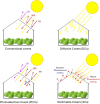Advances in light manipulation in greenhouse horticulture: the innovative smart covers
- PMID: 41127077
- PMCID: PMC12537742
- DOI: 10.3389/fpls.2025.1640530
Advances in light manipulation in greenhouse horticulture: the innovative smart covers
Abstract
Greenhouses play a key role in modern agriculture by creating controlled environments to fulfil specific plant climatic requirements, allowing the extension of the growing season and improving the crop productivity and product quality. Light, in terms of quantity (intensity), quality (spectral composition), and duration (photoperiod), is a crucial factor in driving plant performance in protected cultivation. Solar radiation is significantly affected by the greenhouse framework and cover material. The use of smart materials, including diffusive, photoselective, luminescent, and switchable covers, can positively modify the light intensity, spectrum, and distribution, improving the greenhouse light environment, hence the plant growth, morphology, and metabolism. This review summarizes the state of art of research on innovative covers suitable for modern greenhouse horticulture and their effects on plant performance in vegetable and ornamental crops.
Keywords: diffusive covers; energy efficiency; luminescent covers; photoselective covers; photosynthesis; switchable covers; temperature regulation.
Copyright © 2025 Zamani, Duri, Mori and Paradiso.
Conflict of interest statement
The authors declare that the research was conducted in the absence of any commercial or financial relationships that could be construed as a potential conflict of interest.
Figures



References
-
- Abd El-Aal H. A., Rizk A. M., Mousa I. E. (2018). Evaluation of new greenhouse covers with modified light regime to control cotton aphid and cucumber (Cucumis sativus L.) productivity. Crop Prot. 107, 64–70. doi: 10.1016/j.cropro.2018.01.011 - DOI
-
- Abdel-Galil H. S. (2014). Effect of covering material and shading on interior light intensity in poly-greenhouses. Misr J. Agric. Eng. 31, 327–340. doi: 10.21608/mjae.2014.100007 - DOI
-
- Aldaftari H. A., Okajima J., Komiya A., Maruyama S. (2019). Radiative control through greenhouse covering materials using pigmented coatings. J. Quant. Spectrosc. Radiat. Transf. 231, 29–36. doi: 10.1016/j.jqsrt.2019.04.009 - DOI
-
- Al-Helal I., Alsadon A., Shady M., Ibrahim A., Abdel-Ghany A. (2020). Diffusion characteristics of solar beams radiation transmitting through greenhouse covers in arid climates. Energies 13, 472. doi: 10.3390/en13020472 - DOI
Publication types
LinkOut - more resources
Full Text Sources

